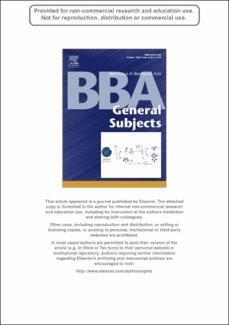| dc.contributor.author | Coronado, Lorena M. | |
| dc.contributor.author | Nadovich, Christopher T. | |
| dc.contributor.author | Spadafora, Carmenza | |
| dc.date.accessioned | 2020-06-23T04:14:14Z | |
| dc.date.available | 2020-06-23T04:14:14Z | |
| dc.date.issued | 2014-02-17 | |
| dc.identifier.issn | 0304-4165 | |
| dc.identifier.uri | http://repositorio-indicasat.org.pa/handle/123456789/105 | |
| dc.description | Malaria is an extremely devastating disease that continues to affect millions of people each year. A distinctive attribute of malaria infected red blood cells is the presence of malarial pigment or the so-called hemozoin. Hemozoin is a biocrystal synthesized by Plasmodium and other blood-feeding parasites to avoid the toxicity of free heme derived from the digestion of hemoglobin during invasion of the erythrocytes. Scope of review: Hemozoin is involved in several aspects of the pathology of the disease as well as in important processes such as the immunogenicity elicited. It is known that the once best antimalarial drug, chloroquine, exerted its effect through interference with the process of hemozoin formation. In the present review we explore what is known about hemozoin, from hemoglobin digestion, to its final structural analysis, to its physicochemical properties, its role in the disease and notions of the possible mechanisms that could kill the parasite by disrupting the synthesis or integrity of this remarkable crystal. Major conclusions: The importance and peculiarities of this biocrystal have given researchers a cause to consider it as a target for new antimalarials and to use it through unconventional approaches for diagnostics and therapeutics against the disease. General significance: Hemozoin plays an essential role in the biology of malarial disease. Innovative ideas could use all the existing data on the unique chemical and biophysical properties of this macromolecule to come up with new ways of combating malaria. | en_US |
| dc.description.abstract | Malaria is an extremely devastating disease that continues to affect millions of people each year. A distinctive attribute of malaria infected red blood cells is the presence of malarial pigment or the so-called hemozoin. Hemozoin is a biocrystal synthesized by Plasmodium and other blood-feeding parasites to avoid the toxicity of free heme derived from the digestion of hemoglobin during invasion of the erythrocytes. Scope of review: Hemozoin is involved in several aspects of the pathology of the disease as well as in important processes such as the immunogenicity elicited. It is known that the once best antimalarial drug, chloroquine, exerted its effect through interference with the process of hemozoin formation. In the present review we explore what is known about hemozoin, from hemoglobin digestion, to its final structural analysis, to its physicochemical properties, its role in the disease and notions of the possible mechanisms that could kill the parasite by disrupting the synthesis or integrity of this remarkable crystal. Major conclusions: The importance and peculiarities of this biocrystal have given researchers a cause to consider it as a target for new antimalarials and to use it through unconventional approaches for diagnostics and therapeutics against the disease. General significance: Hemozoin plays an essential role in the biology of malarial disease. Innovative ideas could use all the existing data on the unique chemical and biophysical properties of this macromolecule to come up with new ways of combating malaria. | en_US |
| dc.language.iso | en | en_US |
| dc.subject | Hemozoin synthesis | en_US |
| dc.subject | Hemoglobin degradation | en_US |
| dc.subject | Hemozoin structure | en_US |
| dc.subject | Hemozoin biophysical | en_US |
| dc.subject | properties Plasmodium falciparum | en_US |
| dc.title | Malarial hemozoin: From target to tool | en_US |
| dc.type | Article | en_US |

